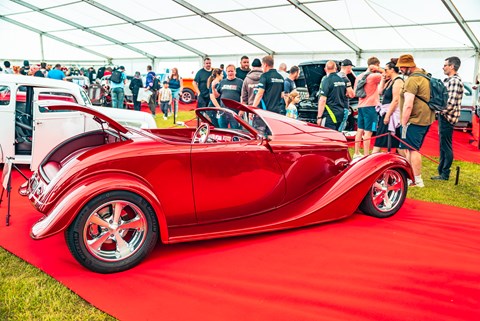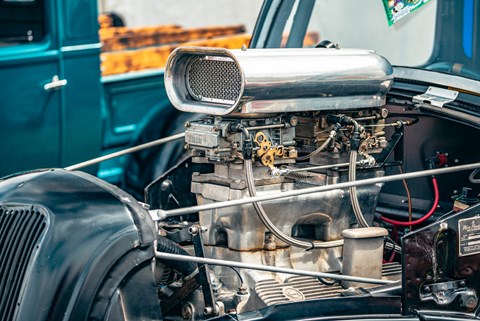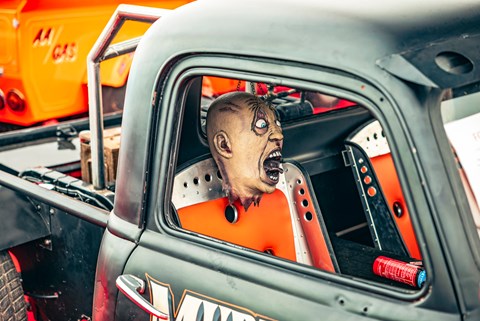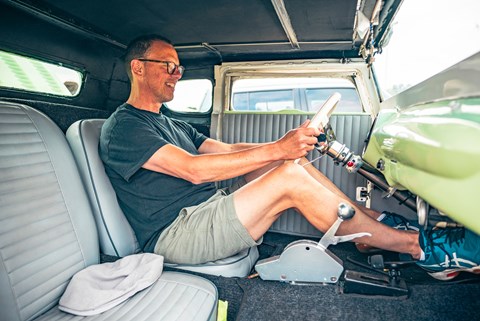► Inside the UK’s hot rod scene
► As full of passion and creativity as the US…
► …with added Blu Tack
Oh God, has it really come to this? I’ve come to the National Hot Rod and Custom Car Show at the Lincolnshire Showground for a trip down memory lane and I’m now standing in a field in the rain. There are about seven cars here, including a van covered in squirrels and a jacked-up Toyota Hilux called Hellboy. Rockabilly music is blasting from the big tent and there are families wandering around with pushchairs, making the best of it and wondering if it’s too early for ice cream.
This is a shock. This is not how I remember things. The hot rod scene of my childhood seemed cool and subversive; it was reckless and a bit racy. It was all about glinting chrome engines, a sparkle of California sunshine, ZZ Top and Daisy Duke in her denim shorts.
But then, maybe my memory is playing tricks. My soft spot for hot rods dates way, way back – all the way back to my pre-teen childhood. In fact, all the way back… to the dinosaurs.
Dinosaurs were my first love, but by the time I was eight or nine I got drawn towards cars. It was inevitable – my dad was a car enthusiast and I grew up in a house which always had copies of Motor Sport and Thoroughbred & Classic Cars lying around. I’m not sure exactly when, but at some point I went into a newsagent and said to my dad, ‘Please can I have that one?’ – and he bought me a copy of Hot Car. Launched in 1968, Hot Car magazine capitalised on the craze for customising that flourished in the UK through the ’70s. When I started reading it at the end of that decade, it would often have a centre spread of a Ford T-bucket or a metalflake Transit, which I would carefully extract by bending back the staples to stick on my wall. Blu Tack was invented in 1970, changing kids’ bedroom walls forever.

In 1979 Street Machine was launched, which seemed more grown-up than Hot Car, with even wilder cars on dragster wheels and flaming paint jobs. And of course there was Custom Car, which had topless models in the centre spread, leaning on the cars with their fake-fur coats and leopard-print leotards. It was tawdry and vulgar and anyway I wasn’t allowed to put Custom Car pictures on my wall.
Then in 1984 I discovered CAR magazine. Next thing, I’m reading about Gavin Green driving a Ferrari 288 GTO. Suddenly, no more flames or fur coats. But because I moved on so quickly – and so absolutely – my hot rod days ended up sealed off, like one of those time capsules you fill with photos and bury in the garden. It turned out that wanting to own a Ford Model A with Daisy Duke’s face airbrushed on the side was just a phase.
But recently I’ve started remembering those cars again, getting all nostalgic about the candy paint colours, the pinstripe detailing and buttoned interiors. It got me wondering about the people and the scene – does British hot rodding still exist? And if so, are T-buckets still a thing? So off I went to the National Hot Rod, Custom & American Car Show to find out.
It’s still raining at the Lincolnshire Showground so I wander into the large marquee tent where the National Street Rod Association (NSRA) has a display. There I find Rick Reynolds standing by his customised 1954 Fordson van. Rick has lots of old photos and magazine articles on show, and it soon becomes clear that Rick, like me, is here to remember.

‘I grew up in the hot rod scene,’ he tells me. ‘When I was a kid, we used to travel every weekend to custom car shows. My dad, Mo Reynolds, got into it in 1978, which was a time of creativity, murals, metalflake paint and gold Dralon seats. He had a 1968 Torino which he customised. Cars were about reflecting the personality of the owner. My dad has passed away now and I came back into it trying to find his car. I tracked it down in Sweden, still with the Dralon seats, the metalflake just about hanging in there, but the great thing is, it survived!’
Rick started a Facebook group called Back To Our Roots, which brings people together to remember the period. ‘As a kid I took loads of photos and shot a lot of Super 8 cine film,’ Rick tells me. ‘The scene has been through many stages, and for a while in the ’90s it kind of died down. Now there’s a nostalgia for that era.’
Another owner whose car is a blast from the past is Andy Hogg, whose red T-bucket is on the NSRA display. T-buckets are the most iconic of all hot rods, dating back to the famous Kookie Kar of 1955. ⊲ Built by a 22-year-old called Norm Grabowski, the Kookie Kar was a cut-down Model T body mounted on a shortened Model A chassis with a Cadillac engine. In 1957, Grabowski was photographed hanging out in Hollywood by a Life magazine photographer, eating a burger in his car. When this iconic picture appeared in a story about Californian car culture, it kick-started a nationwide craze, inspiring thousands of young men to copy the Grabowski car’s exposed engine, raked stance and open, whitewalled wheels.

T-buckets became so popular that by the mid ’60s kits were being sold with fibreglass bodies, and by the ’70s these so-called Fad T kits were being produced here in the UK too, by custom builders like Nick Butler and Geoff Jago. Like all cars, the Model T changed over the years, but the most popular fibreglass bucket was based on the 1923 Roadster. Andy Hogg’s red 23 T is such a car.
‘It’s a ’70s original, and I’m only the third owner,’ Andy tells me. ‘Mine’s one of Nick Butler’s – I’m not sure if it came as a kit but probably most of it was bought from him. It has a fibreglass bucket and a Rover V8, with a supercharger from a Deutz lorry.
Andy’s love of the hot rod scene also goes back to that era. ‘I used to buy Street Machine and Hot Car – I’ve got loads of copies still in the loft,’ he tells me. ‘I used to go to a lot of shows and dream. Years ago, I got Nick Butler’s pamphlet, and I actually bought a Jaguar V12 and gearbox, had it all stripped down, ready to build my own car. Then my wife fell pregnant and it didn’t go ahead.’
Now in his sixties, Andy decided to finally fulfil that ambition and bought his 23 T about six years ago. ‘T-buckets were popular in the ’70s, but they’ve gradually dwindled down and there aren’t many left. I don’t know how much horsepower it has – it’s more about the looks and the sounds. I normally just cruise along at 50mph!’
Nearby is another early T, this time an American original, built in 1967 with a Buick V6. Like many cars on show – from the Hellboy pick-up to a nearby ‘rat rod’ with a skull hanging in the passenger seat – its Addams Family styling is inspired by the macabre. At the rear is Matt Marson, hand-painting some lettering for the car’s owner, Chrissie. It reads: ‘Don’t look at the skull… he will take your soul’ – a reference to the skull-shaped rear diff which lights up at night. Matt, a CNC machinist whose artistic side hustle is called Danger Sign, explains the grisly side of customising as he paints in blood red.

‘There’s definitely a link between hot rodding and horror,’ he tells me. ‘Horror, sci-fi – it’s all outlier art. I’m a massive horror fan and a comic fan. Hot rodding is for people who can’t leave things alone – they have tattoos because they like to modify themselves. You’re into cars that aren’t the ordinary, that people will stop and stare at.’
Like the green van covered in squirrels, for example? I leave Matt to his lettering and wander back outside. The rain has stopped, the sun is out and now – thankfully – dozens of cars have arrived in the show field. It looks a lot more inviting than it did at 10am.
Hot rodding is clearly a broad church, and there’s everything here from a Hummer with a fake machine gun to an Escort van inspired by the Highlander movie – but I have to find out more about that green van. Turns out it’s a 1996 Chevy G20 – and they’re not squirrels after all. The owner, Chris MacKenzie, is sitting beside the van waiting for her husband Duncan to return with bacon sandwiches. The incredible airbrushing was done by an artist called Kev Hill, she tells me. ‘And ⊲ what was the brief?’ I ask. ‘Show the beauty of foxes,’ she answers, immediately. Wow, that’s a specific brief. ‘I love foxes.’
What’s clear – just as Matt explained earlier – is that Chris just can’t leave things alone. ‘It’s been ongoing for years,’ she tells me. ‘We just keep adding to it. These projects are never finished – this is its fourth interior. I get bored with things!’
She opens the side door and shows me inside. ‘I bought a large throne, cut it down and painted it to look like a tree,’ she says, as matter-of-factly as anyone ever could say those words.

Another car has arrived in the sunshine, its gigantic V8 burbling like a dragster as it parks up. I’m immediately drawn to it – for me, this is the car of the show. I ask the owner, Russell Cook, about his incredible creation. ‘It’s a 1930 Model A with a 6.0-litre Chrysler Hemi,’ he tells me. ‘I bought it as a rolling chassis and body from Canada, then basically built what you see. It’s had a six-inch roof-chop and a four-inch channel, which means the body’s lowered over the chassis. So basically you sit on the floor. It’s a proper, traditional hot rod.’
By now, Russell’s story is familiar. ‘I built my first hot rod in my teens, then I got into sports cars and drag racing, then drifted back into hot rods,’ he tells me. ‘You never stop tinkering. When I first built it, it wasn’t supercharged. Then a friend sold me a 6-71 supercharger, and I had to cut the car in half to make it three inches longer, to get the front pulley in. So you’re always fiddling – sometimes big things, sometimes small. It was brown, now it’s green.’
The V8 puts out around 600bhp, which is a lot in a car that’s basically an engine on wheels. ‘I’ve done 120mph in it,’ Russell tells me, ‘but it’s proper scary. It weighs about 1300kg, but 1000 of those is forward of the gearlever, so all the braking is done on those skinny front wheels.’
Russell invites me sit inside. It’s tiny but much more comfortable than I imagined when I first saw the little seat cushion on the floor. The tricky thing is the low roof, which means you have to duck your head to see out. ‘I use it in the summer – my wife I might go out for dinner with friends,’ Russell tells me. ‘I’ve been to Belgium, Germany and France in it. But I’m 62 now and I get a bit of back ache because you have to stoop to drive it.’

Russell is also realistic about the future of the whole hot rod movement. ‘My generation is the last that’ll put a high value on cars like these,’ he reckons. ‘We grew up with movies like American Graffiti. When you grow up on films like Fast & Furious, the cars you aspire to own are Nissan GT-Rs. Why would you want 600bhp that doesn’t handle?’ For now, though, hot rodding is clearly riding a wave of nostalgia, as middle-aged men and women remember the glory days of the 1970s and ’80s. But there’s also a modern twist. Rebellion was always a big part of hot rodding culture – even as a 10-year-old, I could see that. Now these barmy, impractical, often expensive creations look like a revolt against the sanitised EVs we’re all being forced to buy. And having submerged myself once again in the world of chrome V8s and airbrushed foxes, I think I’m ready to join the revolution. I don’t have a hot rod but I can bring the Blu Tack.
Hot rodding’s all-time greats
Hot Rod #1
In 1948 Bob McGee returned to California after the war and modified his 1932 Ford Roadster with a clean, minimalist look (below left). It appeared on the cover of the first issue of Hot Rod magazine and became an icon
Bucking the trend
After featuring in Life magazine in 1957, Norm Grabowski’s ground-breaking roadster inspired the T-bucket craze. Originally called Lightning Bug it starred in a hit TV show, 77 Sunset Strip, and became known as the Kookie Kar
Out there
Ed Roth, the LA artist behind the Rat Fink cartoon character, learned of a new material used by surfers called fibreglass. He hand-moulded the stuff to bring one of his cartoon monsters to life and called it The Outlaw
A capital C
When the T-bucket craze came to the UK in the early ’70s, Nick Butler was a pioneer. In 1976 he built a delivery-van-inspired C-Cab called Revenge (below right), named Best Hot Rod of the Century in 2000
The big bang
In 1978 Nick Butler wanted to build the ultimate T. Andromeda – with its 7.0-litre supercharged V8 and leather interior – took hot rod detailing to a new level. Legend has it Andromeda had 1000bhp and did 0-100mph in 8.0 seconds